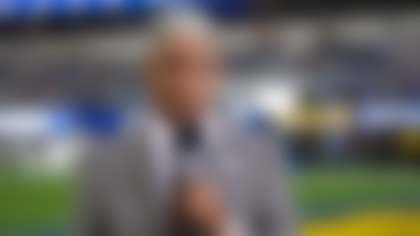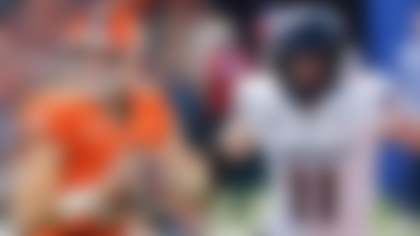NFL franchises use contextualized data to create competitive advantages. In order to realize an edge, teams need to employ the right data in the right way at the right time. This means distilling, interpreting and applying only the most influential data in a framework that accounts for their personnel, their opponents and their evolving game situations. My goal is to be *your analytics department. Each week this season, I want to work for you by giving you a peek into which numbers flag in my models as the most impactful ... or the most misunderstood.*
As always, let me know if your eye test is picking up on something interesting, or if there's a stat/trend you'd like me to take a deeper look at. You can hit me on Twitter @cfrelund. As with any great analytics department, the more collaborative this is, the more value we can create.
Now, let's dig into the relevant data heading into Week 7 of the 2019 NFL season:
NARRATIVE TO BE WARY OF
Jared Goff and Dak Prescott aren't playing well.
Last season, opposing defenders entered a 5-foot halo in Goff's field of vision and decreased his ability to complete passes (i.e. caused disruption) at the 21st-highest rate of 14.4 percent. This season, though, Goff has seen the opposition's disruptive pressure nearly double to 27.6 percent (sixth-most). In terms of win share, my measurements have the O-line unit going from seventh-best in 2018 (2.7) to 24th this season (1.4). Increased penalties and decreased efficiency in the run game partly drive this win-share dip -- and act as a double-whammy in terms of also setting up Goff for passing downs where pressure is more likely. I don't think Sean McVay wanted Goff to spend a game attempting the third-most passing attempts in NFL history -- 68 in the Week 4 loss to Tampa Bay -- but L.A.'s lackluster O-line play is throwing off the team's offensive balance.
In my model, Prescott's win share projection is tracking at QB8 (3.7), which is an increase from his preseason ranking of QB10 (3.6). With significant injuries to Dallas' offensive line, Dak has been under more disruptive (and faster) pressure -- especially on the offensive left, where injured Pro Bowler Tyron Smith would normally be. During the Cowboys' current three-game losing streak, Prescott has faced an overwhelming disruption rate of 29.3. And what exactly do I mean by "faster" pressure? Comparing these three games to his entire 2018 campaign, Prescott is both getting disrupted faster (1.9 seconds vs. 2.3 in 2018) and being forced to scramble more quickly (2.5 seconds vs. 2.7 in '18), thus causing him to attempt passes on the run more often. Prescott led QBs in passer rating under any pressure last season (89.9), but that number is misleading because he only faced disruptive pressure (when an opposing defender enters a 5-foot halo in the QB's field of vision) on 13.5 percent of dropbacks. His skills haven't eroded under pressure this season -- he's just facing more of the pressure he can't do much about.
Bottom line: Offensive lines matter a lot when it comes to quarterback play.
A DEEPER LOOK AT
How the San Francisco 49ers have jumped out to 5-0.
Using my 10-season model to create a baseline for past success (a.k.a. what drove wins) and then finding comparables with this season's teams and results, the 49ers are exhibiting one of the most predictive production combinations for success: efficient defensive pressure and "rushing" success, especially on first down. I use quotes on "rushing" because shorter passes that have the same net impact as a run (e.g. don't stop the clock) are also included here.
Think of it like this: Playing complementary football has netted the Niners wins because their exceptional defensive front works in lockstep with their efficient offense. This increasingly puts opposing offenses in positions where they need to throw, which means more chances for San Francisco's elite-level defensive pressure to limit the continuation of drives and turn the ball over.
Next Gen Stats show that San Francisco's defense has been able to bring pressure at the second-highest rate in the league: 34.7 percent. This is a big uptick from last season, when the Niners ranked 19th at 26.8 percent. Rookie edge rusher Nick Bosa boasts a league-leading pressure rate of 20.7 percent, meaning he applies heat on opposing QBs roughly every fifth pass rush. Fronts and backs of defenses work together, and the 49ers allow the third-lowest passer rating under pressure (37.5) with 12 takeaways (tied for fourth-most). This is a major improvement from 2018, when San Francisco had just seven takeaways all season (fewest for any team in NFL history). In the fourth quarter, the Niners have three takeaways and a 0 percent red-zone touchdown rate allowed, only surrendering 3.4 points per game (tied for fourth-fewest) in the final stanza.
Meanwhile, San Francisco earns the most rushing yards per game on first down (98.8), which helps to drive the fifth-most non-penalty-earned first downs per game (21.2) and leads to the 49ers averaging 29.4 points per game (ranking third). So far this season, the Niners have scored 49 points off takeaways (fourth-most) after only notching 16 points in this capacity all last season (dead last -- for comparison, the second-to-last team managed 40 points off takeaways).
Ahead of the season in my training camp primer, I deemed San Francisco a sleeper team, with the 49ers making the playoffs in more than 54 percent of my preseason simulations. That's certainly looking good at the moment, but let's not count our chickens quite yet. San Francisco's schedule is remarkably challenging down the stretch. Over the final six weeks of the regular season, the Niners have home games against the Packers and Rams, and road trips to Baltimore, New Orleans and Seattle.
TWO SLEEPER PLAYERS
Michael Gallup, WR, Dallas Cowboys: According to Next Gen Stats, the Cowboys receiver has caught 10 of his 15 targets of 10-plus air yards for 242 yards and a touchdown. This helps drive his robust average of 16.1 yards per reception (ranked 15th) and 96.8 yards per game (third, though he missed two games with injury). On passes of 10-plus air yards to Gallup, Prescott owns a 131.9 passer rating. Their opponent this week on "Sunday Night Football," the Philadelphia Eagles, have allowed 10 touchdown passes of 10-plus air yards this season, the second-highest total in the NFL.
Darius Slayton, WR, New York Giants: At 16.8 air yards per target, Slayton ranks third in the NFL among receivers with at least 15 targets, per NGS. He leads the Giants with six receptions of 10-plus air yards. With injuries still a concern in the Giants receiving corps, Slayton is in a great spot to take advantage of a Cardinals defense that is allowing a 139.6 passer rating on passes of 10-plus air yards (the highest figure in the NFL in 2019), with eight touchdowns and zero interceptions. Even with Patrick Peterson slated to return from suspension, Slayton's projected volume means he'll likely be one of the keys to the passing game and the final score.
Follow Cynthia Frelund on Twitter @cfrelund.




